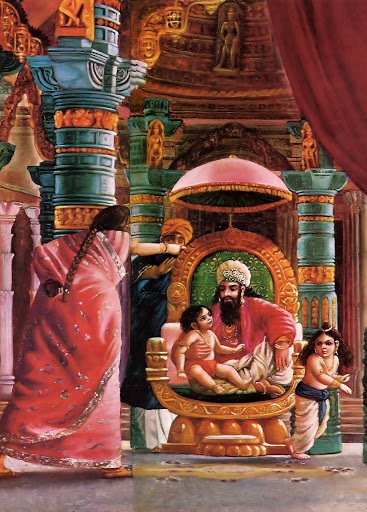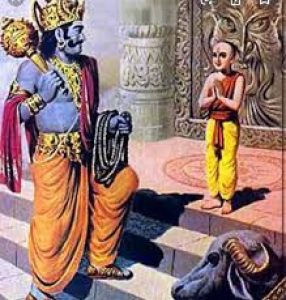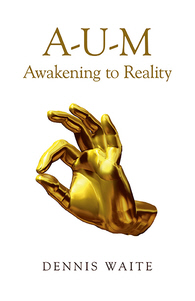 Dhruva was an adorable little boy. He saw his half-brother, Uttama, sitting and playing on the lap of their father, King Uttanapada. He too desired to climb on to the lap of Uttanapada. But his step-mother could hardly tolerate that. She gave a tight slap to him declaring that he was unfit to sit on the lap of the King as he was not born to her but to another queen. Crest-fallen and deeply hurt, the little kid, with his eyes full of tears, ran to his mother. His mother, a highly noble lady, consoled him and advised that he should achieve something so that people look at him with awe. The little Dhruva left the royal palace and went away to a distant forest. He met with a group of Sages in the forest and narrated to them his soulful story. They advised him to meditate on Vishnu. So, he embarked on a very austere and rigorous course of meditation. Regretting heavily the developments, the King and all his retinue, his mother, the queen and all his family implored that he should give up his askesis and return home. The King was even ready to abdicate the throne and promised to coronate him. But Dhruva was unrelenting. He did not succumb to the temptations and was uncompromising in his resolve. He pursued his meditation with greater vigor. He meditated on Vishnu, the Ultimate. Continue reading
Dhruva was an adorable little boy. He saw his half-brother, Uttama, sitting and playing on the lap of their father, King Uttanapada. He too desired to climb on to the lap of Uttanapada. But his step-mother could hardly tolerate that. She gave a tight slap to him declaring that he was unfit to sit on the lap of the King as he was not born to her but to another queen. Crest-fallen and deeply hurt, the little kid, with his eyes full of tears, ran to his mother. His mother, a highly noble lady, consoled him and advised that he should achieve something so that people look at him with awe. The little Dhruva left the royal palace and went away to a distant forest. He met with a group of Sages in the forest and narrated to them his soulful story. They advised him to meditate on Vishnu. So, he embarked on a very austere and rigorous course of meditation. Regretting heavily the developments, the King and all his retinue, his mother, the queen and all his family implored that he should give up his askesis and return home. The King was even ready to abdicate the throne and promised to coronate him. But Dhruva was unrelenting. He did not succumb to the temptations and was uncompromising in his resolve. He pursued his meditation with greater vigor. He meditated on Vishnu, the Ultimate. Continue reading
Tag Archives: world
Dissolving The Apparent World
 On the insistent questioning of the highly determined Naciketas, Lord Yama had no alternative but to reveal the secret code to ending the transient mortal world and realizing the “immortality” that one actually and already is. It is not some thing new that one acquires. It is prAptasya prAptiH (प्राप्तस्य प्राप्ति:). Or, as kaTha says at 2.5.1, विमुक्तश्च विमुच्यते (i.e. becoming freed, one becomes emancipated. In other words, he does not take up a body again).
On the insistent questioning of the highly determined Naciketas, Lord Yama had no alternative but to reveal the secret code to ending the transient mortal world and realizing the “immortality” that one actually and already is. It is not some thing new that one acquires. It is prAptasya prAptiH (प्राप्तस्य प्राप्ति:). Or, as kaTha says at 2.5.1, विमुक्तश्च विमुच्यते (i.e. becoming freed, one becomes emancipated. In other words, he does not take up a body again).
Shankara explains it in his own inimitable way unpacking the involved intricacies in simple words. He writes in his commentary at 1.3.14, kaTha in the following way:
एवं पुरुषे आत्मनि सर्वं प्रविलाप्य नामरूपकर्मत्रयं यन्मिथ्याज्ञानविजृम्भितं क्रियाकारकफललक्षणं स्वात्मयाथात्म्यज्ञानेन मरीच्युदकरज्जुसर्पगगनमलानीव मरीचिरज्जुगगनस्वरूपदर्शनेनैव स्वस्थः प्रशान्तः कृतकृत्यो भवति यतः , अतस्तद्दर्शनार्थमनाद्यविद्याप्रसुप्ताः उत्तिष्ठत हे जन्तवः | — Shankara at 1.3.14, kaTha Upanishad. Continue reading
chAndogya, 3.14.1:
We have had a long discussion on the mantra at 3.14.1 of the chAndogya Upanishad in Oct 2020. We examined its significance from both epistemological and ontological angles. We had also noted that the full thrust of the mantra can be appreciated only if the entire section, and the mantra at 3.14.4 and particularly Shankara’s commentary there on are also taken into account. Otherwise, there is a danger that one may try to read into the mantra a meaning which is not its purpose at all!
Somehow all of us missed a very highly relevant and meaningful point that Shankara makes about this mantra at 1.3.1, BSB . It has a clear bearing on our discussions and settles the issue, IMHO, without any scope for even an iota of doubt. I like to bring it to the attention of all the interested members. Continue reading
Post-Enlightenment Perception
Swami Krishnananda Saraswati of The Divine Life left his mortal coil on this day in 2001. He tells us in his explication of the chAndogya Upanishad that “With the present state of (our) mind it is not possible to understand what the perception of a Jivanmukta could be. We can only have comparisons, illustrations and analogies. But what actually it is, it is not possible for us to understand.”
Nevertheless, for a seeker on the Knowledge path, the topic whether the visible world (which does not exist in reality even now) will continue to appear after Self-realization or not, whether it would disappear like the proverbial snake on the rope or will continue to show up like the ghostly water in a mirage is ever evocative. That is, at least, until the final tipping point happens. The interest in this topic cannot be said to be driven by mere idle academic curiosity. There is a genuine internal “urge” in every seeker to measure up oneself in assessing whether one’s own understanding of the Advaitic doctrine has remained at an intellectual level or has percolated down viscerally. Perception of a world can be a very easily testable “Marker” toward such an end. Continue reading
How To Be Disembodied?
 The Post on “The ‘I-am-realized’ Delusion – 5” said, quoting Shankara, towards its end, that “Disembodiedness is the intrinsic nature of Atman” and that is liberation.
The Post on “The ‘I-am-realized’ Delusion – 5” said, quoting Shankara, towards its end, that “Disembodiedness is the intrinsic nature of Atman” and that is liberation.
अशरीरता हि आत्मनः स्वरूपम् । — Shankara at 8.3.4, chAndogya.
The immediate question that arises then is “How to be disembodied?”
Before we answer this question, it is necessary to be absolutely clear in our mind about who is asking this question and why. If the question is being asked on behalf of the body and the reason for asking is to get rid of the miseries, sorrows and pains that the body undergoes in the world, well, Advaita in general and disembodiment in particular, is not the solution.
Does it mean that the body’s problems of disease, decay, hunger, destitution cannot be solved at all? One cannot say “No.” However, one has to look for some other routes to achieve that. But those routes will not lead one to ‘Liberation’ – freedom from being born in the world. Continue reading
The “I-am-realized” Delusion – 5:
The Non-dual message of the Advaita doctrine is so deceptively simple that one feels tempted to say “I got It,” though in reality s/he has not. Fortunately for us, various scriptures and authorities like Shankara offer a number of means to test ourselves on our progress on the Knowledge Path so that we do not foreclose our sAdhana (practice) too soon. All through this Series of posts, we have been trying to provide many hints and markers that may help a committed seeker in protecting himself/herself from deluding prematurely that s/he is “Self-realized or Enlightened.” It has been our endeavor to present reliable self-appraisal mechanisms based on authentic sources and we shall continue below with a few more easily doable means of verifying the state of our “Realization.”
Shankara does not mince his words when he says at both 1.4.7 and again at 1.4.10, brihadAraNyaka:
अविद्याशोकमोहभयादिदोषनिवृत्तेः प्रत्यक्षत्वादिति चोक्तः | — Shankara at 1.4.10, brihadAraNyaka. Continue reading
The “I-am-realized” Delusion – 4:
We have from Bhagavad-Gita:
ब्रह्मार्पणं ब्रह्म हविर्ब्रह्माग्नौ ब्रह्मणा हुतम् ।
ब्रह्मैव तेन गन्तव्यं ब्रह्मकर्मसमाधिना ॥ — 4.24, Bhagavad-Gita.
Meaning: brahman is the offering, brahman the oblation; by brahman is the oblation poured into the fire of brahman; brahman verily shall be reached by him who always sees brahman in action.
Some people who delude themselves to be Self-realized cite the above verse and argue that they see each and every object to be brahman. It is blatantly an inadmissible argument because it would imply that the indivisible brahman has divided Itself into multiple bits and pieces.
The shruti is very categorical when it tells us:
एकधैवानुद्रष्टव्यमेतदप्रमयं ध्रुवम् । — 4.4.20, brihadAraNyaka:
Meaning: It should be realized in one form only, (for) It is unknowable and eternal.
Shankara comments at the above mantra: “Since It is such, It should be realized in one form only, viz. as homogeneous Pure Intelligence, without any break in it, like the space; for It, this brahman, is unknowable, owing to the unity of everything (in brahman).” Continue reading
Gaudapada and World Appearance
(Extract from the book)
 What exactly happens when a person is enlightened or ‘gains mokSha’? A popular, although somewhat incomprehensible, belief is that the world somehow ‘disappears’; that, for the j~nAnI, there simply is no longer any duality. Quite how the j~nAnI (apparently) continues to eat, drink and converse is not adequately explained by those who hold such a view. But Gaudapada approaches it from a different and even more dramatic angle.
What exactly happens when a person is enlightened or ‘gains mokSha’? A popular, although somewhat incomprehensible, belief is that the world somehow ‘disappears’; that, for the j~nAnI, there simply is no longer any duality. Quite how the j~nAnI (apparently) continues to eat, drink and converse is not adequately explained by those who hold such a view. But Gaudapada approaches it from a different and even more dramatic angle.
Prior to my enlightenment, I make the mistake of identifying myself with the body-mind, believing myself to be a separate entity. This is the result of my Self-ignorance – not realizing that I am the unlimited Atman. Gaudapada says that this ignorance is beginningless (anAdi) (K1.16). At the dawn of Self-knowledge, I recognize that I am not the waker, dreamer or deep-sleeper but the non-dual turIya.
As to whether or not the world then disappears, Gaudapada effectively asks: how can it disappear when it didn’t exist to begin with? “If the visible world actually existed, there is no doubt that it might stop (i.e. disappear) (as soon as j~nAna was gained). (But) this (apparent) duality is merely mAyA (and) the absolute truth is non-dual.” (K1.17) Continue reading
The “I-am-realized” Delusion – 3:
We come across very often in the Western Advaita circles, teachers and well-read writers who do not hesitate to say “I am realized.” Such a deluded belief in claiming Self-realization appears to be based principally on two fallacies. One is that when they say that “I know I am aware,” they falsely assume that they are in touch with the Absolute Awareness. The second is that they think that they see a world of multiple objects even after Self-realization, because the objects apparent to them are preexistent to their perception, all the objects being already ‘brahman‘ — as if the indivisible brahman has made it especially easy for them to perceive Itself (brahman).
As Swami Sarvapriyananda lucidly explains in this Video, about 30 to 32 min into his talk, the awareness one knows when one says “I am aware” is the fallacious or shadow consciousness and not the Absolute Consciousness. An easy verification can also be made by oneself to ascertain if it is the chidabhAsa (reflected Consciousness) or the Absolute brahman through a simple test as suggested by the Swami Ji in that talk. Thus the awareness that they assume to be in touch is not brahman, but the reflected Consciousness only. Continue reading
The “I-am-realized” Delusion – 2:
Dennis raised a question on how one can conclude that the word “this” in the 3.14.1, chAndogya would mean “the ‘Universal’ substratum of the world and not the nAma-rUpa-vyAvahAra which are the perceivables.” His contention is that “this” refers to the percept itself.
If what is directly available for the five sensory organs + mind is itself brahman, neither the Upanishads nor the Advaitic teachers right from Gaudapada, Shankara and so on need to have taken any trouble at all to point out to the seeker what brahman is. On the other hand, all the teachers go to considerable pains to explain that what is available to perception “veils” the Reality, the Substratum and that what is available for perception is a superimposed “falsity” out of our ignorance.
Shankara, in fact, is so tired of repeatedly pointing this fact in all his bhAShya-s that at 2.1.22, BSB, he writes out of exasperation that “We Continue reading
